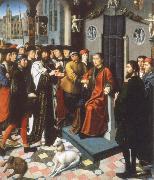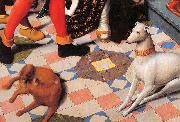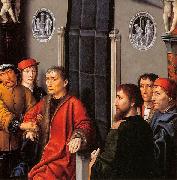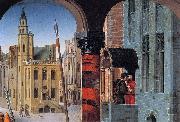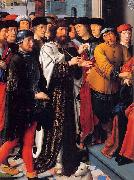Wholesale Oil Painting Reproductions No Minimum and Door to Door! |
|||||||||||
|
|
|||||||||||

|
|||||||||||
|
|
|
||||||||
All Gerard David Oil Paintings |
||||||||
|
|
||||||||
|
|
||||||||
|
Artist Introduction: b.c. 1460, Oudewater, Neth.
d.Aug. 13, 1523, Bruges
Flemish Gerard David Locations
Netherlandish painter. He is known as the last of the Flemish Primitives. Although born in the northern Netherlands, he moved to Bruges as a young man, and most of his work expresses the impassive, unmannered, microscopically realistic approach peculiar to south Netherlandish art in the time of Jan van Eyck. David was skilled at synthesizing the art of several important south Netherlandish predecessors, adapting, for instance, the compositions of van Eyck and the technique of Hugo van der Goes. He was also influenced by Hans Memling, whose example led him to refine and polish his cruder northern Netherlandish style and to adopt the popular theme of the Virgin and Child enthroned. |
||||||||
|
|
||||||||
|
the judgment of cambyses Painting ID:: 55983 |
mk247
1498,oil on panel,71.75x125.5 in,182.5x318.5 cm,groeninge museum,bruges,belgium |
|||||||
Height Width |
INS/CM Quality |
|||||||
|
X |
| |||||||
|
|
||||||||
All Gerard David Oil Paintings |
||||||||
|
|
||||||||
|
|
||||||||
|
Artist Introduction: b.c. 1460, Oudewater, Neth.
d.Aug. 13, 1523, Bruges
Flemish Gerard David Locations
Netherlandish painter. He is known as the last of the Flemish Primitives. Although born in the northern Netherlands, he moved to Bruges as a young man, and most of his work expresses the impassive, unmannered, microscopically realistic approach peculiar to south Netherlandish art in the time of Jan van Eyck. David was skilled at synthesizing the art of several important south Netherlandish predecessors, adapting, for instance, the compositions of van Eyck and the technique of Hugo van der Goes. He was also influenced by Hans Memling, whose example led him to refine and polish his cruder northern Netherlandish style and to adopt the popular theme of the Virgin and Child enthroned. |
||||||||
|
|
||||||||
|
|
The Judgment of Cambyses Painting ID:: 91784 |
1498(1498)
Medium oil on panel
cyf |
||||||
Height Width |
INS/CM Quality |
|||||||
|
X |
| |||||||
|
|
||||||||
All Gerard David Oil Paintings |
||||||||
|
|
||||||||
|
|
||||||||
|
Artist Introduction: b.c. 1460, Oudewater, Neth.
d.Aug. 13, 1523, Bruges
Flemish Gerard David Locations
Netherlandish painter. He is known as the last of the Flemish Primitives. Although born in the northern Netherlands, he moved to Bruges as a young man, and most of his work expresses the impassive, unmannered, microscopically realistic approach peculiar to south Netherlandish art in the time of Jan van Eyck. David was skilled at synthesizing the art of several important south Netherlandish predecessors, adapting, for instance, the compositions of van Eyck and the technique of Hugo van der Goes. He was also influenced by Hans Memling, whose example led him to refine and polish his cruder northern Netherlandish style and to adopt the popular theme of the Virgin and Child enthroned. |
||||||||
|
|
||||||||
|
|
The Judgment of Cambyses Painting ID:: 91785 |
1498(1498)
Medium oil on panel
cyf |
||||||
Height Width |
INS/CM Quality |
|||||||
|
X |
| |||||||
|
|
||||||||
All Gerard David Oil Paintings |
||||||||
|
|
||||||||
|
|
||||||||
|
Artist Introduction: b.c. 1460, Oudewater, Neth.
d.Aug. 13, 1523, Bruges
Flemish Gerard David Locations
Netherlandish painter. He is known as the last of the Flemish Primitives. Although born in the northern Netherlands, he moved to Bruges as a young man, and most of his work expresses the impassive, unmannered, microscopically realistic approach peculiar to south Netherlandish art in the time of Jan van Eyck. David was skilled at synthesizing the art of several important south Netherlandish predecessors, adapting, for instance, the compositions of van Eyck and the technique of Hugo van der Goes. He was also influenced by Hans Memling, whose example led him to refine and polish his cruder northern Netherlandish style and to adopt the popular theme of the Virgin and Child enthroned. |
||||||||
|
|
||||||||
|
|
The Judgment of Cambyses Painting ID:: 91788 |
1498(1498)
Medium oil on panel
cyf |
||||||
Height Width |
INS/CM Quality |
|||||||
|
X |
| |||||||
|
|
||||||||
All Gerard David Oil Paintings |
||||||||
|
|
||||||||
|
|
||||||||
|
Artist Introduction: b.c. 1460, Oudewater, Neth.
d.Aug. 13, 1523, Bruges
Flemish Gerard David Locations
Netherlandish painter. He is known as the last of the Flemish Primitives. Although born in the northern Netherlands, he moved to Bruges as a young man, and most of his work expresses the impassive, unmannered, microscopically realistic approach peculiar to south Netherlandish art in the time of Jan van Eyck. David was skilled at synthesizing the art of several important south Netherlandish predecessors, adapting, for instance, the compositions of van Eyck and the technique of Hugo van der Goes. He was also influenced by Hans Memling, whose example led him to refine and polish his cruder northern Netherlandish style and to adopt the popular theme of the Virgin and Child enthroned. |
||||||||
|
|
||||||||
|
|
The Judgment of Cambyses Painting ID:: 91789 |
1498(1498)
Medium oil on panel
cyf |
||||||
Height Width |
INS/CM Quality |
|||||||
|
X |
| |||||||
|
|
||||||||
All Gerard David Oil Paintings |
||||||||
|
|
||||||||
|
|
||||||||
|
Artist Introduction: b.c. 1460, Oudewater, Neth.
d.Aug. 13, 1523, Bruges
Flemish Gerard David Locations
Netherlandish painter. He is known as the last of the Flemish Primitives. Although born in the northern Netherlands, he moved to Bruges as a young man, and most of his work expresses the impassive, unmannered, microscopically realistic approach peculiar to south Netherlandish art in the time of Jan van Eyck. David was skilled at synthesizing the art of several important south Netherlandish predecessors, adapting, for instance, the compositions of van Eyck and the technique of Hugo van der Goes. He was also influenced by Hans Memling, whose example led him to refine and polish his cruder northern Netherlandish style and to adopt the popular theme of the Virgin and Child enthroned. |
||||||||
|
|
||||||||
|
|
The Judgment of Cambyses Painting ID:: 91790 |
1498(1498)
Medium oil on panel
cyf |
||||||
Height Width |
INS/CM Quality |
|||||||
|
X |
| |||||||
|
|
||||||||
All Gerard David Oil Paintings |
||||||||
|
|
||||||||
|
|
||||||||
|
Artist Introduction: b.c. 1460, Oudewater, Neth.
d.Aug. 13, 1523, Bruges
Flemish Gerard David Locations
Netherlandish painter. He is known as the last of the Flemish Primitives. Although born in the northern Netherlands, he moved to Bruges as a young man, and most of his work expresses the impassive, unmannered, microscopically realistic approach peculiar to south Netherlandish art in the time of Jan van Eyck. David was skilled at synthesizing the art of several important south Netherlandish predecessors, adapting, for instance, the compositions of van Eyck and the technique of Hugo van der Goes. He was also influenced by Hans Memling, whose example led him to refine and polish his cruder northern Netherlandish style and to adopt the popular theme of the Virgin and Child enthroned. |
||||||||
|
|
||||||||
|
|
The Judgment of Cambyses Painting ID:: 91791 |
1498(1498)
Medium oil on panel
cyf |
||||||
Height Width |
INS/CM Quality |
|||||||
|
X |
| |||||||
|
|
||||||||
|
Prev Next
|
||||||||
|
|
||||||||
|
Related Paintings to Gerard David :. |
||||||||
|
|
||||||||
|
CONTACT US |
